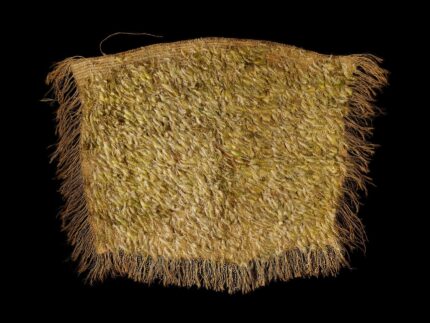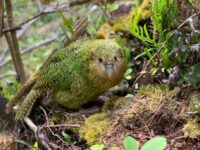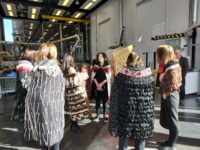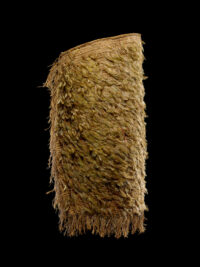 The only surviving complete example of a Māori kahu kākāpō, a traditional cloak made of the feathers of the critically endangered green, ground-dwelling kākāpō parrot, has been restored and put on display for the grand opening of the new Perth Museum in Perth, Scotland.
The only surviving complete example of a Māori kahu kākāpō, a traditional cloak made of the feathers of the critically endangered green, ground-dwelling kākāpō parrot, has been restored and put on display for the grand opening of the new Perth Museum in Perth, Scotland.
The kākāpō, charmingly nicknamed the moss chicken, is the world’s only flightless parrot and was once common on the three main islands of New Zealand. Its population began to decline with the arrival of Polynesian settlers. The humans hunted them for their meat and feathers and the rats the humans brought with them devastated  their eggs and chicks. The arrival of Europeans drove them to the brink of extinction. Attempts to maintain populations of the birds in nature preserves began in the late 19th century, but were thwarted by introduced predators like stoats and feral cats. Finally in the 1980s the Kākāpō Recovery plan was developed, establishing populations on islands cleared of predators. Breeding and feeding programs have helped bring a small population of around 270 back, and just last year the first kākāpō were reintroduced to the mainland.
their eggs and chicks. The arrival of Europeans drove them to the brink of extinction. Attempts to maintain populations of the birds in nature preserves began in the late 19th century, but were thwarted by introduced predators like stoats and feral cats. Finally in the 1980s the Kākāpō Recovery plan was developed, establishing populations on islands cleared of predators. Breeding and feeding programs have helped bring a small population of around 270 back, and just last year the first kākāpō were reintroduced to the mainland.
The cloak was collected by David Ramsay, a native of Perth who sailed to Australia as a ship’s surgeon in 1823 and stayed there. He gave the kahu kākāpō and the rest of his collection to the Perth Literary and Antiquarian Society in 1842. The cloak is believed to have been made in the early 1800s, after contact with Europeans, and was well-preserved overall, but the feathers and plant fibers it is made of are so inherently fragile that any handling at all can cause damage and loss.
 Today the kahu is in the permanent collection of the Perth Museum and Art Gallery (PMAG). PMAG turned to the British Museum’s Organic Artefact Conservation studio for expert assistance in treating the delicate materials and brought in a Māori curatorial advisor from the Museum of New Zealand Te Papa Tongarewa to ensure the taonga (meaning “treasure”) was treated in keeping with Māori cultural practices.
Today the kahu is in the permanent collection of the Perth Museum and Art Gallery (PMAG). PMAG turned to the British Museum’s Organic Artefact Conservation studio for expert assistance in treating the delicate materials and brought in a Māori curatorial advisor from the Museum of New Zealand Te Papa Tongarewa to ensure the taonga (meaning “treasure”) was treated in keeping with Māori cultural practices.
Once arrived at the British Museum, the cloak was examined to determine the areas of greatest concern. The feather shafts and the dried, unprocessed stands of New Zealand flax (pōkinikini) required urgent stabilization.
The feathers of the kākāpō had been woven into the ground weave of the cloak by their very fine, thin shafts. Over time, some of the feathers had become bent, partially split at their shafts, or completely detached from the weave. To support them, a strong but lightweight mulberry paper was used, after being toned and cut to match the colour and very narrow lengths of each damaged shaft, which were often less than 2mm wide. Each piece was then carefully secured along individual shafts with a conservation grade adhesive and left to dry under gentle pressure.
The treatment of the pōkinikini required similarly delicate care. The black, dyed sections along the pōkinikini lengths were likely coloured with an iron-tannin dye, which over time had eaten away at the fibres, making the dyed areas exceedingly weak.
To support these areas, narrow strips of lightweight mulberry paper were toned to match the pokinikini’s alternating dyed and undyed stripes. The paper strips were then applied as discreet bridges, linking sections of damaged pōkinikini to ensure no areas were lost. For other types of damage, toned mulberry paper was pulped into fibres, and then carefully inserted into the centre of the cylindrical pōkinikini strand to bring together and support the split fibres. Overall, the treatment for these fragile elements required more than 100 hours of sustained focus and manual dexterity, along with very fine-tipped forceps and strong magnification!
 To investigate how this cloak was worn, the team made a mock-up of a stand to drape it on. They realized the wear pattern in the feathers on the left and top edges suggests the cloak was worn with an opening on the right. The holds where the laces were threaded through were barely stretched at all, indicating the cloak was worn rarely. The museum then made a custom mount so it can be displayed safely.
To investigate how this cloak was worn, the team made a mock-up of a stand to drape it on. They realized the wear pattern in the feathers on the left and top edges suggests the cloak was worn with an opening on the right. The holds where the laces were threaded through were barely stretched at all, indicating the cloak was worn rarely. The museum then made a custom mount so it can be displayed safely.
The new Perth Museum, located in the former Perth City Hall, officially opened its doors Saturday, March 30th, with the kahu kākāpō one of the key displays.